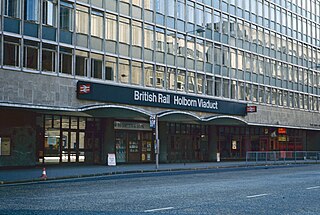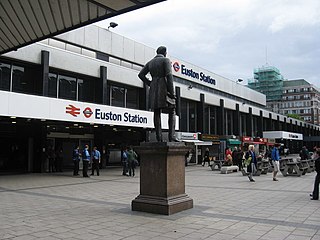
Thameslink is a 24-hour main-line route in the British railway system, running from Bedford, Luton, St Albans City, Peterborough and Cambridge via central London to Sutton, Orpington, Sevenoaks, Rainham, Horsham and Brighton. The network opened as a through service in 1988, with severe overcrowding by 1998, carrying more than 28,000 passengers in the morning peak. All the services are currently operated by Govia Thameslink Railway.

The Jubilee line is a London Underground line that runs between Stratford in east London and Stanmore in the suburban north-west, via the Docklands, South Bank and West End. Opened in 1979, it is the newest line on the Underground network, although some sections of track date back to 1932 and some stations to 1879.

London Bridge is a central London railway terminus and connected London Underground station in Southwark, south-east London. It occupies a large area on three levels immediately south-east of London Bridge, from which it takes its name. The main line station is the oldest railway station in London fare zone 1 and one of the oldest in the world having opened in 1836. It is one of two main line termini in London to the south of the River Thames and is the fourth-busiest station in London, handling over 50 million passengers a year.

Charing Cross is a London Underground station at Charing Cross in the City of Westminster. The station is served by the Bakerloo and Northern lines and provides an interchange with Charing Cross mainline station. On the Bakerloo line it is between Embankment and Piccadilly Circus stations and on the Northern line it is between Embankment and Leicester Square stations. The station is in fare zone 1.

Aldwych is a closed station on the London Underground, located in the City of Westminster in Central London. It was opened in 1907 with the name Strand, after the street on which it is located, and was the terminus of the short Piccadilly line branch from Holborn that was a relic of the merger of two railway schemes. The station building is close to the Strand's junction with Surrey Street, near Aldwych. During its lifetime, the branch was the subject of a number of unrealised extension proposals that would have seen the tunnels through the station extended southwards, usually to Waterloo.

King's Cross Thameslink station is a closed railway station in central London, England. It is located on Pentonville Road, around 250 metres (0.2 mi) east of King's Cross mainline station. At the time of closure, in 2007, it was served by Thameslink trains and managed by First Capital Connect.

Blackfriars, also known as London Blackfriars, is a central London railway station and connected London Underground station in the City of London. It provides Thameslink services: local, and regional and limited Southeastern commuter services to South East London and Kent. Its platforms span the River Thames, the only one in London to do so, along the length of Blackfriars Railway Bridge, a short distance downstream from Blackfriars Bridge. There are two station entrances either side of the Thames, along with a connection to the London Underground District and Circle lines.

Snow Hill tunnel is a railway tunnel on the northern edge of the City of London which carries the up and down Snow Hill lines between City Thameslink and Farringdon stations. The tunnel runs beneath the Smithfield meat market and was constructed, using the cut-and-cover method, immediately prior to the building of the market. The tunnel opened on 1 January 1866.

City Thameslink is a central London railway station within the City of London, with entrances on Ludgate Hill and Holborn Viaduct. The station is on the Thameslink route between Blackfriars to the south and Farringdon to the north.

The Jubilee Line Extension (JLE) is the extension of the London Underground Jubilee line from Green Park to Stratford through south and east London. An eastward extension of the line was first proposed in the 1970s. As part of the development of London Docklands, the line was extended to serve Canary Wharf and other areas of south and east London. Construction began in 1993, and it opened in stages from May to December 1999.

Holborn Viaduct is a road bridge in London and the name of the street which crosses it. It links Holborn, via Holborn Circus, with Newgate Street, in the City of London financial district, passing over Farringdon Street and the subterranean River Fleet. The viaduct spans the steep-sided Holborn Hill and the River Fleet valley at a length of 1,400 feet (430 m) and 80 feet (24 m) wide. City surveyor William Haywood was the architect and the engineer was Rowland Mason Ordish.

Holborn Viaduct was a railway station in the City of London, providing local and commuter services. It was located to the southeast of Holborn Viaduct, and east of Farringdon Street.
The Southern Region was a region of British Railways from 1948 until 1992 when railways were re-privatised. The region ceased to be an operating unit in its own right in the 1980s. The region covered south London, southern England and the south coast, including the busy commuter belt areas of Kent, Sussex and Surrey. The region was largely based upon the former Southern Railway area.

The London station group is a group of 18 railway stations served by the National Rail network in central London. The group contains all 14 terminal stations in central London, either serving major national services or local commuter routes, and 4 other through-stations that are considered terminals for ticketing purposes. All current stations in the group fall within London fare zone 1. A ticket marked "London Terminals" allows travel to any station in the group via any permitted route, as determined by the National Routeing Guide.

Ludgate Hill was a railway station in the City of London that was opened on 1 June 1865 by the London, Chatham and Dover Railway (LC&DR) as its City terminus. It was on Ludgate Viaduct between Queen Victoria Street and Ludgate Hill, slightly north of St. Paul's station on the site of the former Fleet Prison.

Ludgate Circus is a road junction in the City of London where Farringdon Street/New Bridge Street crosses Fleet Street/Ludgate Hill.

The Thameslink Programme, originally Thameslink 2000, was a £6 billion project in south-east England to upgrade and expand the Thameslink rail network to provide new and longer trains between a wider range of stations to the north and to the south of London. The development facilitated new cross-London journeys, which means that passengers no longer have to change trains in London. Work included platform lengthening, station remodelling, new railway infrastructure, and new rolling stock. The project was originally proposed in 1991 following the successful introduction of the initial Thameslink service in 1988. After many delays, planning permission was granted in 2006 and funding was approved in October 2007. Work started in 2009 and was completed on 18 September 2020, although trains over the new routes began running in 2018.

The A201 is an A road in London running from Kings Cross to Bricklayer's Arms.
Surrey Docks North was an authorised underground railway station planned by London Underground but never built. It was to be located in Rotherhithe and named after the Surrey Commercial Docks in the London Borough of Southwark, in east London as a station on an unbuilt extension of the Jubilee line to Woolwich Arsenal.

The Holborn Viaduct–Herne Hill line is a railway line between Holborn Viaduct in the City of London and Herne Hill in the London Borough of Lambeth. After the closure of Holborn Viaduct station the line ends at the south portal of Snow Hill tunnel merging into Snow Hill lines. From there the Widened Lines to St Pancras and Kentish Town are reached. Today the section north of Blackfriars is part of the Thameslink core. Originally being a branch line of the London, Chatham and Dover Railway (LCDR) towards the City of London, the line is sometimes called LCDR City Branch.



















